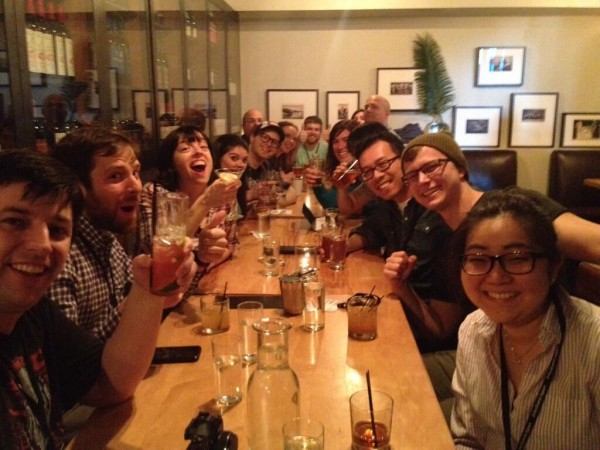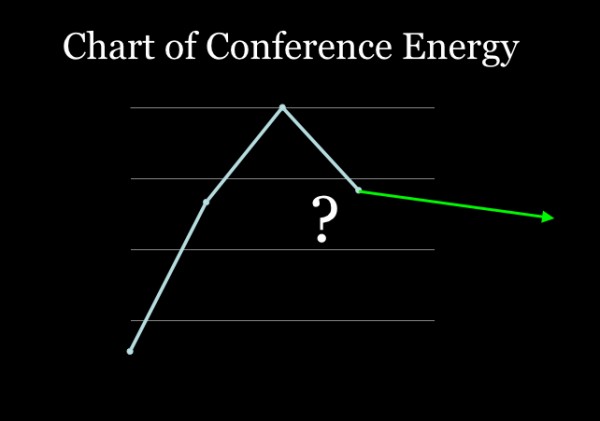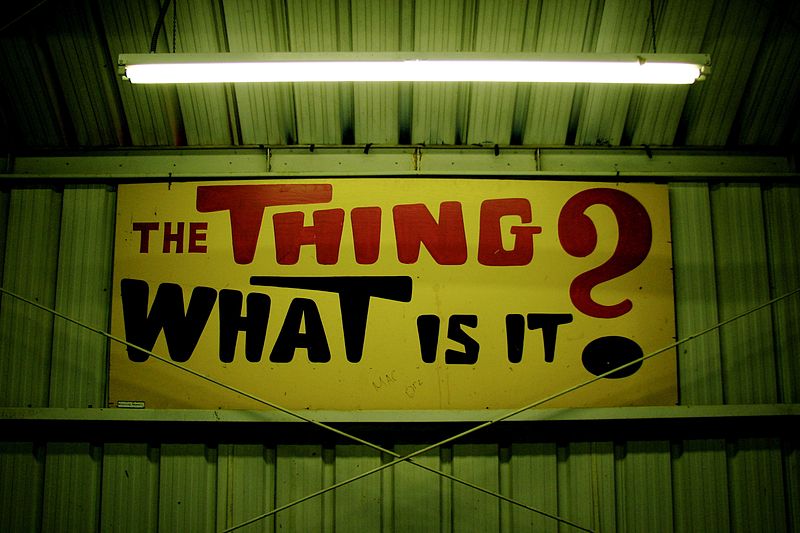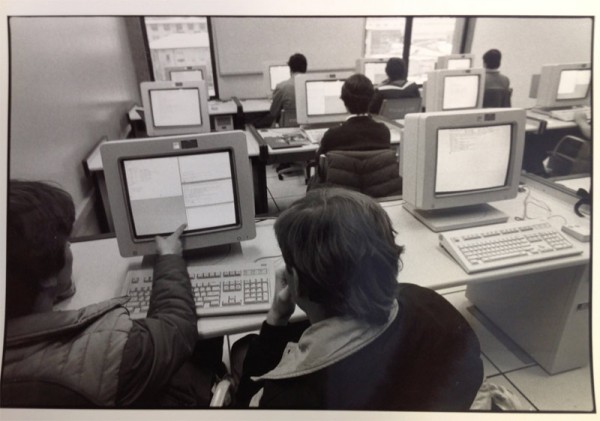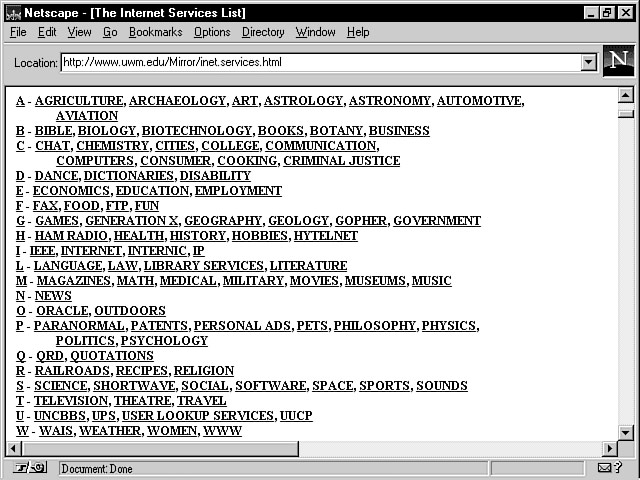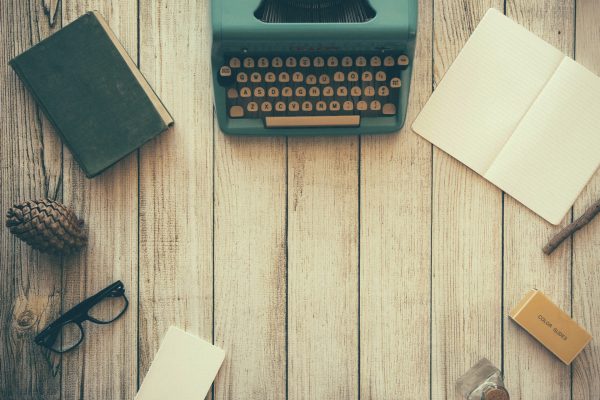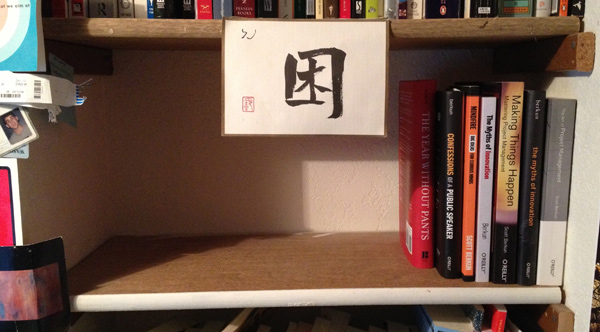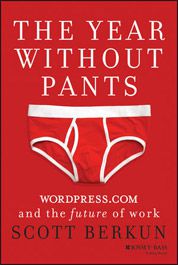 It has been a great few months for The Year Without Pants (the book about my year managing a team at WordPress.com). The book was named an Amazon.com best book of the year, earning attention from Forbes, Publisher’s Weekly, CNN, The Wall Street Journal, Fast Company, ZDNet, and hundreds more. You can get the book in print, kindle and audio, as well as other digital formats.
It has been a great few months for The Year Without Pants (the book about my year managing a team at WordPress.com). The book was named an Amazon.com best book of the year, earning attention from Forbes, Publisher’s Weekly, CNN, The Wall Street Journal, Fast Company, ZDNet, and hundreds more. You can get the book in print, kindle and audio, as well as other digital formats.
I’ve been interviewed dozens of times and here are the most common questions. Matt Mullenweg, my boss in the book, did a follow-up interview on his Podcast.
0: What makes remote work hard?
- Remote work and work from home are different. For working remotely, it’s figuring out habits that work for your psychology, shifting culture to be more autonomous and learning to be a better communicator. For work from home, it’s establishing new boundaries, since you don’t get them for free like you do when work is in a different physical space. It requires more self-awareness and better habits to do these things successfully. But the rewards of independence and work/life balance can be significant.
- Improving work culture. Many workplaces are stuck in a command and control mindset. Remote work is best when employees are trusted and evaluated on their results more than what time of day they work or how they get things done (provided results are good). Meetings, or any synchronous activity that requires people doing the same thing at same time, become very expensive. The culture should shift to use other tools, documents + comments and chat rooms, so people have more freedom about when they get their work done.
- Shifting to better tools. Email and meetings are the mainstays of most workplaces, but they have disadvantages that are overlooked. Documents and chat rooms can be searched and archived, so people can read/contribute on their own schedules and new employees can get up to speed faster. Most organizations that shift to remote replicate all the same habits and tools, they’re just online now. But they should be asking “what problem was this meeting created to solve?” and “what other tools can we use now that we’re remote to solve this?”
1: What were the biggest lessons you learned?
If I thought I could summarize 18 months of my life into a bulleted list I wouldn’t have written a book. But here goes (From 5 Ideas About The Future of Work, published on Copyblogger & @ FastCompany):
- Workers should be treated like adults and be empowered to choose how and where they work. Many organizations pay people well, but treat them like children with far too many rules and processes. Only 13% of workers report that they feel engaged at work which suggests there is something wrong with the basic philosophy of management in most organizations.
- Your location, clothes, and hours (should) matter less than your output. It’s common to reward people who come in early and stay late, but what does that have to do with their work performance? Not much. We all want to be judged fairly for our output, and this should include the possibility of being productive when remote.
- You can escape from email and meeting hell. The banes of modern work are email and meetings but it doesn’t have to be this way. WordPress.com has proven it. (See Is There Life After Email? and Shut Down Your Office) There are better tools and cultures for communication.
- Culture always wins over tools and technologies, but most of the business world is tone deaf to understanding culture.
- Hire by trial. There is little scientific evidence that resumés and interview loops are effective methods for hiring staff. The job interview process itself is dubious, since few interviewers are truly skilled at doing it without bias. WordPress.com hires by trial – you audition for a job, allowing both parties real exposure to the talents and limitations of the other.
This is a lot to absorb or believe. Which is why I wrote a book about a place that has bet everything on these ideas.
The following themes were on my mind as I wrote the book:
- There is no innovation without experimentation. Many people talk about wanting big ideas, but it’s rare that talk is matched with action.The grand frustration in the working world is stasis. Even if you don’t think what WordPress.com does can work for you, you must respect their willingness to experiment. The fact that WordPress.com hired me, a veteran big company manager, shows their willingness to mix things up and learn from the results. Isn’t that what our leaders are supposed to be paid to do? If we demand anything from managers, and perhaps from ourselves, it’s to take the first step, and learning from WordPress.com is an easy place to start.
- Workplaces are buried in unquestioned and unproven traditions that should be tested and the story of WordPress.com raises those questions.
- WordPress.com successfully defies conventional wisdom about hiring, offices, empowerment, incentives, management, intellectual property, hierarchy and more. They are the best case study I knew of for asking questions about work and what alternatives are on the horizon for the modern workplace.
The justification for the subtitle (The Future of Work) is that rather than prescribe 5 dubious commandments like many business books do, we need to explore an actual example and have an expert (me in this case) bring their expertise to bear in the reporting. This approach reveals different lessons depending on the reader’s own experiences. I didn’t know of a management book like this so I felt I should I write it. The Year Without Pants has been criticized for not being prescriptive enough, which was by design. If I’m mostly prescribing, I’m failing to capture what the reality of this kind of workplace was like.
2. Did WordPress.com know you were going to write a book when they hired you?
Yes. The book’s introduction explains this. Matt Mullenweg (WordPress founder) offered me a leadership role and I said I’d do it only if I could write about it. He agreed. My team knew about it early on, and much of the company knew about it before I left after working there 20 months. Since 2003 I’ve been primarily an author and I couldn’t imagine taking a conventional job unless I could frame it as research for a writing project. I was hired in August 2010 and left May 2012. The book released Sept 2013.
3. Most characters in the book are men – does this reflect Automattic accurately?
The book was focused on my team, which happened to be mostly men. WordPress.com’s staff is listed on their public list of employees. which at last count (in 2013) had 39 women in a company of ~180. This is in a typical range for a software company. However, I do regret not exploring issues of gender directly in some way.
The book does mention Hanni Ross, the woman who was the team lead for the Happiness team at the time, in chapters two and six but she’s far from a main character in the book. Although the fascinating way the Happiness (support) team works, with *all* new employees working there for their first three weeks, is the focus of chapters two through four.
I hoped the company photo in chapter 7, which shows exactly how diverse the company was, or, wasn’t, at the time (9 women to ~45 men if I count correctly) would help give a sense of the wider company. Today (2014) there are many women in development and some in leadership roles. I’m convinced remote work improves diversity since most of what you experience is people’s output – rather than superficial things that have little bearing on someone’s ability, but that are easier to form biases around in typical workplaces (height, race, age, physical attractiveness, questionable smells, abundant (or insufficient) piercings, etc.).
Another point that could have been made clearer was geographic diversity. It’s mentioned early on the company hires the best talent anywhere in the world since no relocation isn’t necessary, but the cultural diversity this offers isn’t emphasized. In the section on Results vs. Tradition I do strongly make the case that superficials are distractions, but I should have driven the point home harder that remote work, and as a result WordPress.com, helps reduce gender, age and other biases, since you see far more of a coworkers output than their outward appearances.
You can see a map of all of their employees by location and it’s impressive. They are extremely diverse geographically: http://automattic.com/map/
4. Did working remotely really work?
Yes, but I don’t advocate that it’s for everyone. I do advocate empowering employees to experiment for themselves in how best to be productive, including trying remote work.
But you should recognize that most of us already do significant work remotely today (See Why Isn’t Remote Work More Popular?). Consider this: what % of your working day is spent working with co-workers through a computer screen? I’d guess it’s 30-60%. In any of those moments you could be anywhere on the planet and do the same work. And the rest of the time is mostly in meetings we all complain about anyway. What is it we’re so afraid of to even give remote work a try? It’s an insane paradox. We hate things about work, but we defend those very same things whenever an alternative we haven’t even tried is proposed. About 20% of workers worldwide work remotely and that number will continue to climb as technologies improve.
A good, collaborative team that likes their work and has clear goals can do excellent work remotely. If a team is neither good, nor collaborative, it’s the fault of management, which has nothing to do with working remotely or not.
5. But what about Yahoo/HP/etc. banning remote work?
Yahoo has been a company in crisis for years: why are we using them as an example for emulation? Same for HP. Culture change, even in our supposed high tech high paced world, is slow. Many workplaces still require everyone to wear suits and skirts, and arrive at 9am, despite there being zero data this makes anyone happier or more productive.
This is a central question of the book: when was the last time you put your workplace traditions to the test? Is there really a rational basis for your assumptions about how work is best done?
6. How can I convince my boss to let me work remotely?
See How To Convince Your Boss To Try Things.
Two steps. 1. Do great work and get a great performance review. 2. Ask to try working remotely on a trial basis (perhaps one or two days a week). If in a month your performance is just as good, ask to continue. No good boss would refuse a request from a great worker than has no threat to worsen their performance.
If your boss is afraid to try, or can’t because of official policy, send them a copy of The Year Without Pants or Remote. Or look for a remote friendly company to work for, there’s a list of 100% remote companies here and hundreds more with liberal remote work policies.
7. Did working without email really work?
Yes, but I don’t advocate it’s for everyone. I do advocate it’s everyone’s job to look for and experiment with better ways of being productive, including communication tools other than email. If you try something and it fails, that’s one thing. But not to try at all? That’s shameful, especially if your organization claims to be progressive.
Since I left Automattic they switched from using IRC to using Slack and they’re not alone.
For within team interactions email has major limitations. Chapter 15 of the book, titled The Future of Work Part 2, documents exactly how we worked on a daily basis and how it compared to an e-mail centric culture. The modern workplace has pushed email too far and we know it. There are alternatives for within team communication that are better, but few have tried them.
Fundamentally the culture of most organizations is bureaucratic, forcing employees to seek permission and to cover their asses in email, confusing politics with productivity (See Is There Life After Email? @ FastCompany). In a healthy autonomous culture the pressure on email, and communication, is much lower. I’d fix the culture in an organization before I worried about the tools.
8. Did the experiment of having a non-programmer team leader work?
Yes. It’s not a new experiment really as plenty of important companies are led by people who aren’t a specialist in whatever the company does. Leadership and management are general, not specialized, skills. I think I can lead a team that does just about anything because of my ability to lead, and my interest in and ability to learn what I don’t know. Being an expert is not mandatory to be a leader, and is possibly a limitation in some cases. What matters is being able to make use of experts and synthesize their opinions into good decisions for projects.
9. The book mentions hiring by trial but never goes into the details. Can you elaborate?
Founder Matt Mullenweg explains the process in this Harvard Business article. I was involved with several trials and found the process straightforward and nearly magical. This commitment to working with people on real projects before hiring them explains why many of company policies work. People who would struggle with them are filtered out through hire-by-trial, which is exactly what a hiring process for an organization should do. It took more time to work with candidates than an interview loop would. But for that investment the candidates who asked better questions, were proactive about getting what they needed to complete their project and fit well into the communication tools and styles we were obvious. And those who struggled were obvious too. Instead of talking as a team about how a candidate answered questions, we could talk about what they had built, how they dealt with miscommunications, etc. a much better data set to use to evaluate who to add to your company.
10. What happened after you left WordPress.com?
Everything exploded!
No, that’s not true. Automattic and WordPress.com have been doing very well. WordPress.com is the 8th most popular website in the U.S. The book closes with my departure (May 2012) and the team structure with leads and all has continued to this day. Many of the folks who were on my team became leads on other teams which was nice to see. Automattic currently has more than 210 300 employees and expects to grow at a similar fast pace this year (they’re hiring btw).
When the book released I was invited to speak at the 2013 Automattic company meetup to talk about the book. Most employees seemed to like it and I’m still friends with many of them. It’s a strange thing to have a book written about a place you work, and I understand that feeling.
Recently they announced they took a $160 million round of funding, putting their valuation at $1.16 billion dollars.
11. Would the virtual, self deterministic org model work for a company that needs to market it’s products?
First, many organizations are dysfunctional. I don’t think the traditional ways organizations are structured set a high bar – you’re assuming that it ‘works.’ The Jetpack project (chapter 17, +) demonstrated my team’s ability to launch a specific product on a specific day. Our team worked well together and working on a deadline turned out not to be any more challenging than it would have been for a traditionally managed company, and perhaps it was easier to achieve since we had far less politics to put up with.
12. How can an existing company either accommodate or make the transition to being distributed?
For general advice see How To Change A Company. It’s the best advice for any kind of change to any organization. Change is hard because of culture, not technology. You have to start small, get it right, and repeat.
Chapter 15 of the book, titled The Future of Work Part 2, offers advice on the general way it happens: one person at a time. A worker has to say to their boss “hey, I can be just as, or more, productive if you let me work remotely. Let’s try it and see.” And then the boss has to say, “Yes”. If that experiment goes well, it will be repeated by others. This is the primary way change happens anywhere: two smart people agreeing to try something and then, when it works, agreeing to do it more and convincing others to follow. There’s no magic: just two open minded people.
It will usually be the youngest managers, on the youngest teams, at the youngest companies, that are willing to try new things first. They have fewer preconceptions and fewer things to fear. It’s no surprise most of the 100% distributed companies I’ve found are young software companies. But do consider that most remote workers on the planet are at large corporations (Aetna, American Express, IBM, etc.) where the financial payoffs of remote work have outweighed their fears. Someone at each of those companies had to be first to pitch the argument for experimenting with remote workers.
Of course a team leader, or an executive, can accelerate change if they have control over policies. But typically people with control over policies are conservative: they’ll wait for the existence of a highly productive and vocal minority with enough influence before even considering changing policy. If YOU, reading this, want to work remotely, it starts with you pitching your boss to give it a try. If they see it as a win for you to win by working remotely, they’ll naturally promote the idea.
If you want to see a post purely about how to do that pitch, leave a comment, or submit the question here. (Also: My general advice on pitching ideas).
13. How can distributed work scale?
It already has. As mentioned above, most of the remote workers on the planet are at large corporations (Aetna, American Express, IBM, etc.). The U.S. space program in the 1960s employed 250,000 people in dozens of cities across the country. Every major armed force in history did most of it’s fighting in remote units. We have countless examples of large scale remote work. Think of the telegraph and the telephone, which allowed people hours apart to work together and collaborate. Remote work is old, but our fears cloud our memories. Microsoft, Google, and hundreds of companies have people working in different offices who magically are able to get work done without always sharing the same physical space.
Automattic is currently about 250 people. I could easily see the company reach 1000 people, with 5 product units each with about 200 people in them. Everything within those units would be much the same as it is now. Continuous deployment is part of how Automattic works and it helps with scale: since new ideas launch regularly you rarely have large dependencies between teams. The challenge with scale is for leaders of each unit, assuming they existed (and the units were not self-organizing collectives as some people theorize as ideal), to avoid the traps of middle-management, and maintain the same employee driven autonomy the company has now, while keeping the company lined up on strategy.
The history of work is useful here too. Read about the U.S. civil war or WWII or the Peloponnesian War. Armed forces in the grand wars of the past were intensely distributed, with thousands of soldiers working on what was supposed to be a singular strategy, separated by enormous distances. Messages were sent by runners and horses: ridiculously slow compared to Skype or SMS. My point is that there are plenty of examples of large scale distributed work if you look for them. My success and failures described in The Year Without Pants rarely hinged on my team being distributed or not.
Of course most companies fail. Most projects fail. We give a disproportionate amount of attention to absurdly successful things. If WordPress or Automattic fails in some significant way my first thought would not be to question the fact that they’re distributed, and the book does critique other elements of the company and the culture appropriately.
14. Results vs. Process seems to be a theme: are they really either/or ?
Only good processes keep politics at bay. Mediocre processes amplify politics by creating more turf and more restrictions. Any process should include a clause that defines when the process is no longer necessary. This almost never happens and the result is rules live on forever even after if their usefulness died years ago. Process should be a slave to results, but it rarely is. It’s often the other way around.
15. This is a really interesting observation: “Every manager is kind of a new experiment, and any experiment that goes wrong should change.” Do companies promoting someone to manager need to change what and how they evaluate success?
70% of all American employees are unengaged at work (Gallup 2013). All of those workers work for managers who are failing them. Management, as a discipline, is a failure: we are not, on average, good at it as a nation. We should be experimenting with the very notion of management itself: why not elect managers? Or promote them only on a trial basis? Or give the people who work for them the power to reverse a promotion? As wild as these ideas might sound I bet any of them would provide better results than that 70% number. The bar for management is that low.
As Americans it’s absurd how we never consider democratic principles for management. Instead we have a system modeled on what: monarchy? Oligarchy? I’m no radical, but I am open to other influences in structuring how the powerful are chosen at corporations.
16. It seems that storytelling, relationships, humor – ie the humanity of WordPress.com – is so consciously intented – and with great results. But didn’t they launch it with this in mind? How would a 200 year old company, say, with layers of tradition even begin to try to change its culture to get at a more meaningful workplace?
My story at Automattic is all about culture change: It was a suicide mission for me to introduce traditional management ideas into a company born of open source, independence and autonomy. I was an outsider with a radically different set of beliefs and experiences, which makes the core story of the book one about culture change: or at least my insane attempts to make culture change happen.
Any 200 year old company didn’t start that way. It was grown and you change a company the same way: you plant seeds and nurture them. One bright manager plants a small seed in their own team with some different rules. When they show better results than other teams, other managers follow. Soon there is a high performing minority and if the CEO has a clue they’ll invest in how to make that minority the majority. One way to read the The Year Without pants is “the year of attempting culture change.” How can an expert on management be useful in a place that doesn’t believe in management at all? That’s my story and that’s what the book is about.
17. It’s rare for a “business” book to involve the journalist taking a full time job. How did you approach this project?
I approached the project journalistically, inspired by NewJack and Down and Out In Paris and London. I wanted to report on a place from the inside, but from the first person, not third. I’m often disappointed by books about organizations where the writer never gets their hands dirty: how can you know the heart of a place if all you do is observe? I believe you have to participate to best capture an experience. To minimize betraying the trust of the team I lead, I chose to focus on my story and perspective, minimizing the need to report on private conversations or personal issues. Also working remotely made focusing on my story natural and fitting for the project.
Every journalist who is not too stupid or too full of himself to notice what is going on knows that what he does is morally indefensible. He is a kind of confidence man, preying on people’s vanity, ignorance or loneliness, gaining their trust and betraying them without remorse.
— Janet Malcolm, American journalist and author (b. 1934), in The Journalist and the Murderer
We forget that all the books we read about real people and real organizations required someone to get inside and report on it to the rest of us. I don’t agree with Malcolm that journalists are exclusively immoral, but they frequently must choose between giving the reader, or the subject, the benefit of the doubt. You should think carefully about the books or articles you read in this respect.
18. You say in this book “the bottleneck is never code or creativity; its clarity” Is this the biggest issue in the way for companies trying to move forward?
Any moderate sized corporation is a wasteland of indecisiveness: it’s all committees, review meetings and endless email chains. We all know too many people have veto powers. If you simply clarified who was the equivalent of a film director for a product, or a division, who was empowered to break ties, everyone would be freed to do better work: they’d spend more time actually working and less time fighting over turf. The Year Without Pants explores this in many ways, as the autonomy of the culture created bottlenecks of a kind all on their own.
(Some answers originally posted here and here)
What question did you want me to answer in the book that I didn’t cover? Leave a comment and I’ll add it to this post.
 I’m fascinated by religious history and love movies, so it’s no surprise I’ve seen many films with religious themes. Even when I’m familiar with the texts they refer to, I often go back to reread and compare how the filmmakers handled the many challenges of trying to make a narrative movie about texts written for very different purposes. Most bible movies fall under the pressure to convert these stories into modern forms. The Ten Commandments, as over the top as it can be, is one of the best of these attempts. While The Bible, starting George C. Scott, Richard Burton and Elizabeth Taylor is perhaps the worst (though its coverage of the tower of Babel is the only one I’ve ever seen on film).
I’m fascinated by religious history and love movies, so it’s no surprise I’ve seen many films with religious themes. Even when I’m familiar with the texts they refer to, I often go back to reread and compare how the filmmakers handled the many challenges of trying to make a narrative movie about texts written for very different purposes. Most bible movies fall under the pressure to convert these stories into modern forms. The Ten Commandments, as over the top as it can be, is one of the best of these attempts. While The Bible, starting George C. Scott, Richard Burton and Elizabeth Taylor is perhaps the worst (though its coverage of the tower of Babel is the only one I’ve ever seen on film).

